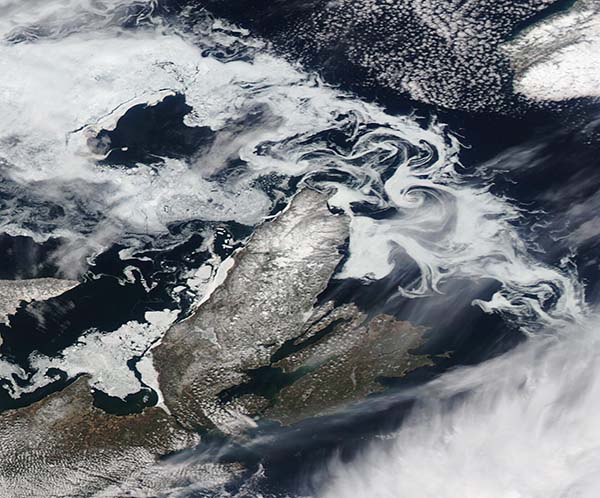Images
March 18, 2022 - Spring Sea Ice off of Cape Breton Island, Nova Scotia
Tweet
The Gulf of St. Lawrence off of Canada’s Cape Breton Island was decorated by floating filigrees of sea ice in mid-March 2022. The Moderate Resolution Imaging Spectroradiometer (MODIS) on board NASA’s Aqua satellite acquired a true-color image of the icy scene on March 16.
Bright white fast ice clings to the southwestern coast of Cape Breton Island while sheets of sea ice float in the Northumberland Strait between the island and Prince Edward Island and in the Gulf of St. Lawrence. Sea ice is basically just frozen water that floats over a large body of water, while fast ice clings to the shoreline and is not carried by winds and wave.
Young sea ice is typically thin enough to be easily moved by winds and currents. Likewise, as floating sheets of ice melt, the edges become thin and can be carried by wind and currents to form fanciful designs. Small filigrees of ice can be seen off the northern edge of the large raft of sea ice over the Gulf of St. Lawrence, but the real show sits off the north and northeastern coast of Cape Breton Island, where strong currents created impressive patterns in the floating ice. Warming spring temperatures and lengthening daylight contribute to the thinning of the ice that has accumulated in this region over the winter.
Image Facts
Satellite:
Aqua
Date Acquired: 3/16/2022
Resolutions:
1km (67.3 KB), 500m (143.3 KB), 250m (321.8 KB)
Bands Used: 1,4,3
Image Credit:
MO'DIS Land Rapid Response Team, NASA GSFC
Tweet
The Gulf of St. Lawrence off of Canada’s Cape Breton Island was decorated by floating filigrees of sea ice in mid-March 2022. The Moderate Resolution Imaging Spectroradiometer (MODIS) on board NASA’s Aqua satellite acquired a true-color image of the icy scene on March 16.
Bright white fast ice clings to the southwestern coast of Cape Breton Island while sheets of sea ice float in the Northumberland Strait between the island and Prince Edward Island and in the Gulf of St. Lawrence. Sea ice is basically just frozen water that floats over a large body of water, while fast ice clings to the shoreline and is not carried by winds and wave.
Young sea ice is typically thin enough to be easily moved by winds and currents. Likewise, as floating sheets of ice melt, the edges become thin and can be carried by wind and currents to form fanciful designs. Small filigrees of ice can be seen off the northern edge of the large raft of sea ice over the Gulf of St. Lawrence, but the real show sits off the north and northeastern coast of Cape Breton Island, where strong currents created impressive patterns in the floating ice. Warming spring temperatures and lengthening daylight contribute to the thinning of the ice that has accumulated in this region over the winter.
Image Facts
Satellite:
Aqua
Date Acquired: 3/16/2022
Resolutions:
1km (67.3 KB), 500m (143.3 KB), 250m (321.8 KB)
Bands Used: 1,4,3
Image Credit:
MO'DIS Land Rapid Response Team, NASA GSFC




